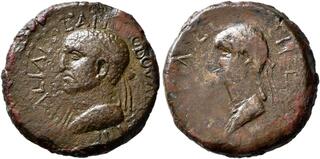Lot description:
KINGS OF ARMENIA MINOR. Aristobulus, with Salome, 54-92. Tetrachalkon (Bronze, 22 mm, 6.87 g, 12 h), Chalcis (?), RY 13 = 66/7. BACIΛEΩC APICTOBOYΛOY ET IΓ Diademed and draped bust of Aristobulus to left. Rev. [BACI]ΛIC-CHC [CAΛOMHC] Diademed and draped bust of Salome to left. Hendin 1257a. Kovacs 300. Meshorer 365 corr. (date). RPC I 3840. Rare. Somewhat smoothed and with some deposits, otherwise, fine.
Ex Leu Web Auction 25, 11 March 2023, 1002 and previously from a European collection, formed before 2005.
The infamous Jewish princess Salome was the daughter of Herodes II and Herodias, a son and a granddaughter of Herodes 'the Great'. Her reputation as a devious seductress comes from Mark (6:21-28) and Matthew (14:6-11), who describe how Salome performed a captivating erotic dance for Herod Antipas. As a reward, her thrilled stepfather promised her to fulfill any wish she may utter: 'Whatever you ask me for, I will give it to you, up to half my kingdom'. Salome consulted with her mother, Herodias, who told her to ask for the head of John the Baptist, as he had criticized her own divorce from Herodes II and her subsequent marriage to Herod Antipas. The tetrarch had previously refused to execute the preacher, but when the teenage girl now demanded his head as a reward for her dance, Herod complied and had one of his bodyguards bring John's head on a platter.
A few years later, Salome married Aristobulus, the son of Herod of Chalcis, who was appointed King of Armenia Minor in 54 by Nero. The present coin is one of just very few known examples to show the king on the obverse and his queen, Salome, on the reverse. It may have been struck in Aristobulus' capital Nicopolis-ad-Lycum, although it has been suggested that the actual mint may have been Antioch (Kovacs) or, more convincingly, Chalcis (RPC).
Starting price: 100 CHF |  |